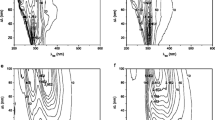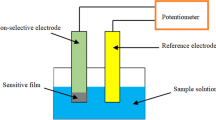The application of synchronous fluorescence spectroscopy combined with chemometrics using pretreated spectra was explored to develop a rapid, low-cost, and nondestructive method for discriminating between brands of different strong aroma type liquors. Principal component analysis, partial least square discriminant analysis, support vector machine, and back-propagation artificial neural network techniques were used to classify and predict the brands of liquor samples. Compared with the other models, the SVM model achieved the best results, with an identification rate of 100% for the calibration set, and 96.67% for the prediction set. The overall results showed that synchronous fluorescence spectroscopy with an efficient chemometrics method can be used successfully to identify different brands of liquor.
Similar content being viewed by others
References
W. Fan and M. C. Qian, J. Agric. Food Chem., 54, 2695–2704 (2006).
Y. Xu, D. Wang, W. Fan, X. Mu, and J. Chen., Adv. Biochem. Eng. Biotechnol., 122, 189–233 (2010).
Y. Ma, D. Huo, H. Qin, C. Shen, P. Yang, and C. Hou, J. Appl. Spectrosc., 84, 361–368 (2017).
P. Cheng, W. Fan, and Y. Xu, Food Res. Int., 54, 1753–1760 (2013).
P. Cheng, W. Fan, and Y. Xu, Food Control, 35, 153–158 (2014).
W. Fan and M.C. Qian, J. Agric. Food Chem., 53, 7931–7938 (2005).
P. Wang, Z. Li, T. Qi, X. Li, and S. Pan, Food Chem., 169, 230–240 (2015).
H. Qin, D. Huo, L. Zhang, L. Yang, S. Zhang, M. Yang, C. Shen, and C. Hou, Food Res. Int., 45, 45–51 (2012).
M. Liu, X. Han, K. Tu, L. Pan, J. Tu, L. Tang, P. Liu, G. Zhan, Q. Zhong, and Z. Xiong, Food Control, 26, 564–570 (2012).
Q. Zhang, C. Xie, S. Zhang, A. Wang, B. Zhu, L. Wang, and Z. Yang, Sens. Actuators B: Chem., 110, 370–376 (2005).
Z. Li, P. Wang, C. Huang, H. Shang, S. Pan, and X. Li, Food Anal. Methods, 7, 1337–1344 (2014).
V. Uríčková and J. Sádecká, Spectrochim. Acta, A, 148, 131–137 (2015).
D. Dong, W. Zheng, W. Wang, X. Zhao, L. Jiao, and C. Zhao, Food Chem., 155, 45–49 (2014).
H. Qiao, W. Zhang, and W. Wang, J. Biosci. Bioeng., 115, 405–411 (2013).
Y. Wan, F. Pan, and M. Shen, Spectrochim. Acta, A, 96, 605–610 (2012).
D. Patra and A. K. Mishra, Trends Anal. Chem., 21, 787–798(2002).
F. Cui, Q. Zhang, X. Yao, H. Luo, Y. Yang, L. Qin, G. Qu, and Y. Lu, Pestic. Biochem. Phys., 90, 126–134 (2008).
J. Sádecká, J. Tóthová, and P. Májek, Food Chem., 117, 491–498 (2009).
J. Sádecká, V. Uríčková, K. Hroboňová, and P. Májek, Food Anal. Methods, 8, 58–69 (2015).
M. Tomková, J. Sádecká, and K. Hroboňová, Food Anal. Methods, 8, 1258–1267 (2015).
J. Sádecká, M. Jakubíková, P. Májek, and A. Kleinová, Food Chem., 196, 783–790 (2016).
J. Tan, R. Li, and Z. Jiang, F ood Chem., 184, 30–36 (2015).
H. Hotelling, J. Educ. Psychol., 24, 417–520 (1933).
W. Li, L. Bagnol, M. Berman, R. A. Chiarella, and M. Gerber, Int. J. Pharm., 380, 49–54 (2009).
P. Geladi and B. Kowalski, Ana l. Chim. Acta, 185, 1–17 (1986).
M. Barker and W. Rayens, J. Ch emometr., 17, 166–173 (2003).
C. Cortes and V. Vapnik, Mach. Learn., 20, 273–297 (1995).
U. Thissen, M. Pepers, B. Üstün, W. J. Melssen, and L. M. C. Buydens, Chemometr. Intell. Lab. Syst., 73, 169–179 (2004).
S. S. Keerthi and C. Lin, Neural Comput., 15, 1667–1689 (2003).
R. H. Nielsen, Proc. Int. Joint Conf. Neural Networks, IEEE Press, 593–605 (1989).
J. J. More, Lect. Notes Math., 630, 105–116 (1978).
Y. Liu, X. Luo, Z. Shen, J. Lu, and X. Ni, Opt. Rev., 13, 303–307 (2006).
S. Wagner, K. Scholz, M. Donegan , L. Burton, J. Wingate, and W. Volkel, Anal. Chem., 78, 1296–1305 (2006).
Author information
Authors and Affiliations
Corresponding author
Additional information
Published in Zhurnal Prikladnoi Spektroskopii, Vol. 85, No. 6, pp. 978–984, November–December, 2018.
Rights and permissions
About this article
Cite this article
Zhu, ZW., Chen, GQ., Wu, YM. et al. Discrimination of Brands of Strong Aroma Type Liquors Using Synchronous Fluorescence Spectroscopy and Chemometrics Methods. J Appl Spectrosc 85, 1101–1106 (2019). https://doi.org/10.1007/s10812-019-00765-w
Received:
Published:
Issue Date:
DOI: https://doi.org/10.1007/s10812-019-00765-w




